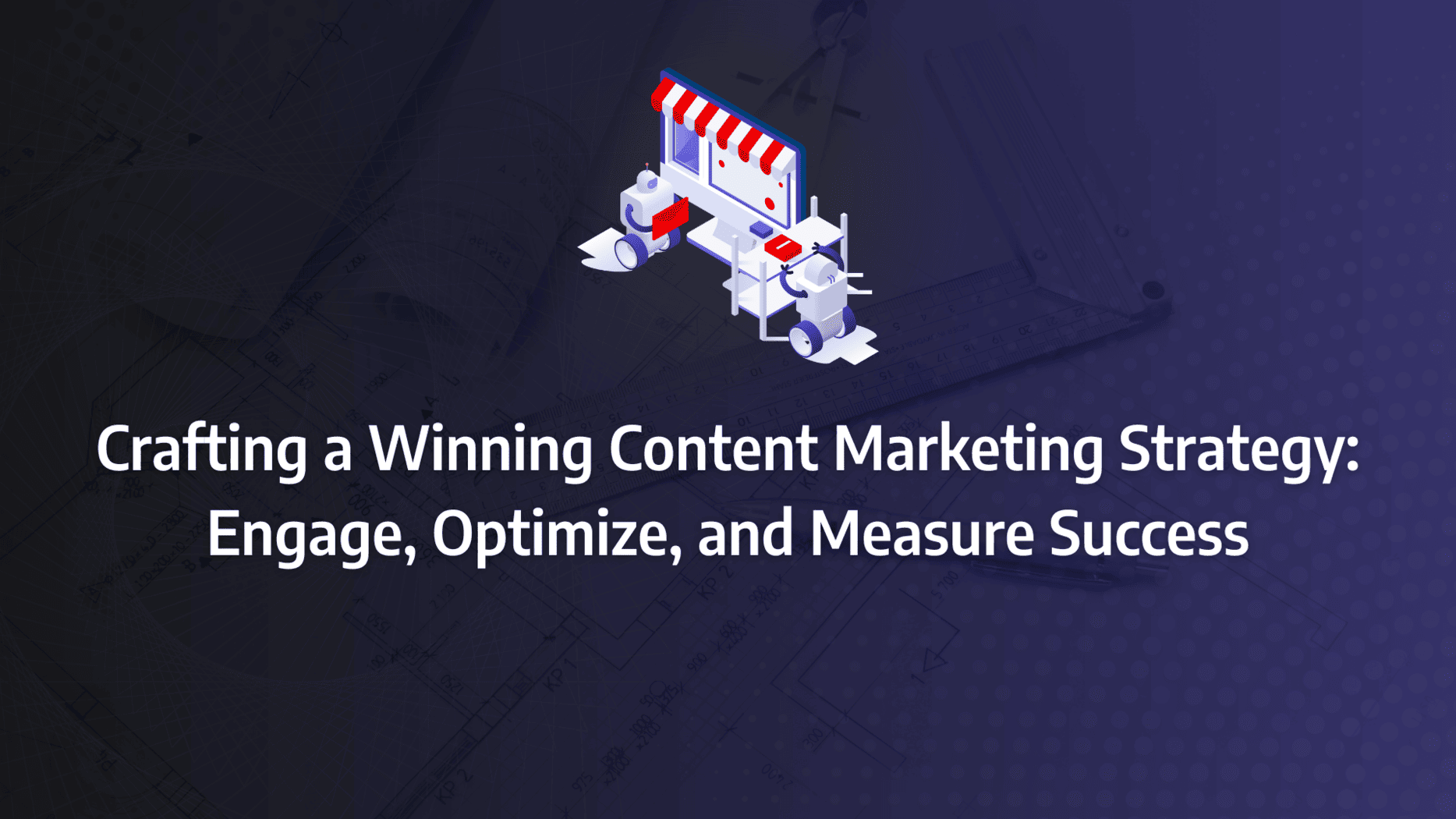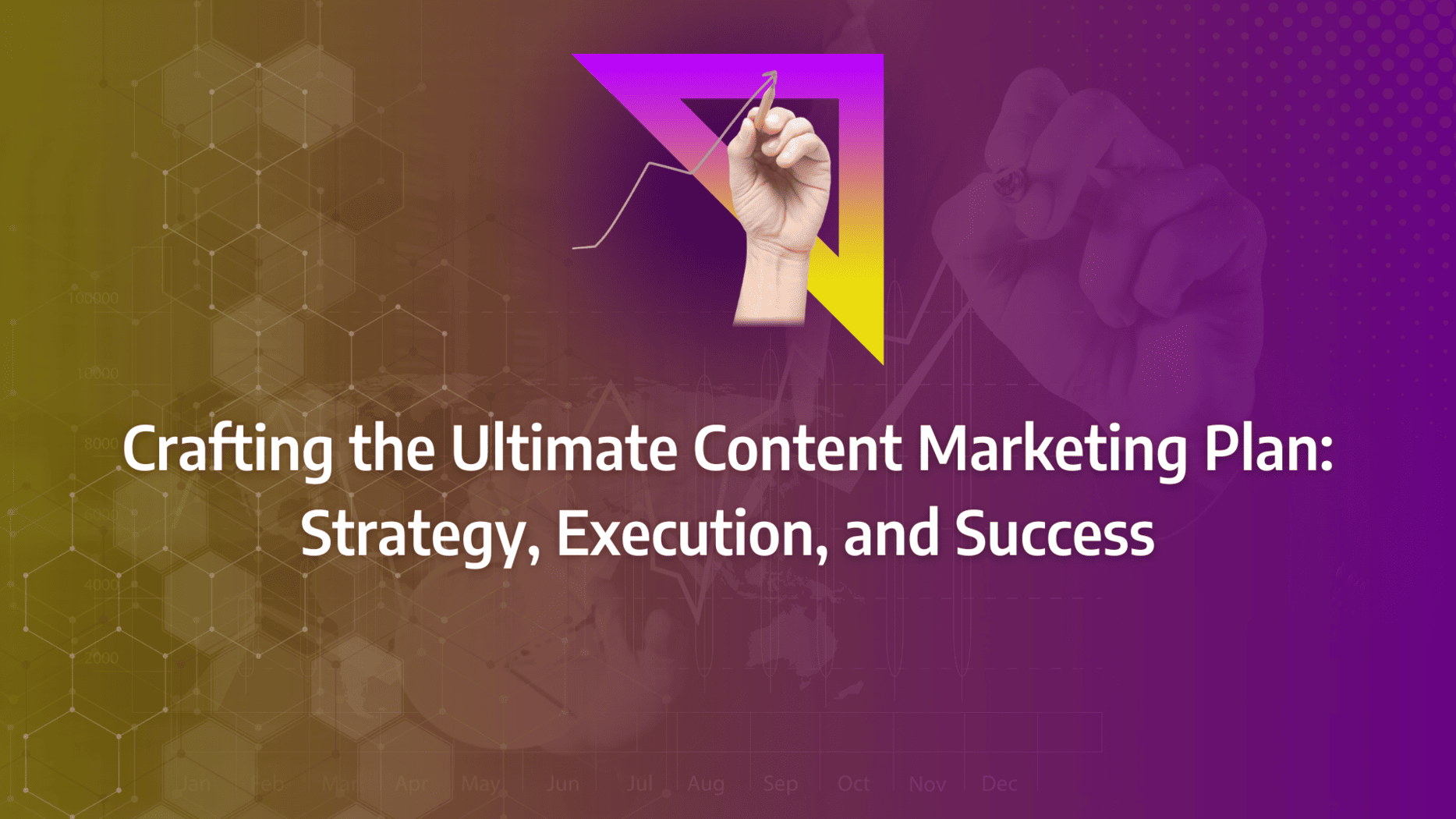Crafting a content marketing strategy that truly resonates with your audience can feel like navigating a maze. You know that the right strategy can elevate your brand, but where do you start? In a landscape overflowing with content, standing out requires more than just great ideas—it demands a strategic approach that aligns your content with your business goals, optimises it for search engines, and measures its success at every turn.
In this guide, you’ll uncover the proven strategies that top brands use to engage their audiences, optimise their content, and measure their impact. We’ll delve into the actionable steps that transform a good content plan into a winning one. Ready to unlock the secrets to content marketing success?
- Align your content strategy with business objectives to ensure every piece of content supports your overarching goals and drives measurable results.
- Understand your audience deeply by creating detailed buyer personas, allowing you to craft content that speaks directly to their needs and challenges.
- Utilise data-driven insights to guide your content creation process, ensuring that your strategy is both targeted and effective.
- Optimise content for SEO by incorporating best practices, such as keyword integration and content repurposing, to maximise reach and engagement.
- Set up key performance indicators (KPIs) to measure the success of your content marketing strategy, and adjust tactics based on real-time data.
- Leverage various content distribution channels, including social media, email marketing, and paid advertising, to expand your reach and engage your target audience effectively.
5 Key Elements for Easily Building an Effective Content Marketing Strategy
An effective content marketing strategy can amplify website traffic by 7.8 times while being 62% more cost-effective than outbound marketing. Hence, content marketing is essential for numerous successful businesses. Below are the five core elements derived from industry-leading practices that you should incorporate into your strategy to reap the benefits.
What Matters Most?
From our experience, clients often discover that aligning content strategy with overarching business goals is critical, ensuring that every piece of content contributes to measurable outcomes. Typically, we find that focusing on customer-centric content drives the most significant engagement and brand loyalty, as it resonates deeply with the audience’s needs. Moreover, building a content community rather than just an audience can transform passive followers into active advocates, fostering long-term relationships and enhancing brand credibility. These strategic elements are the foundation of a successful content marketing approach that adapts and thrives in a dynamic market.Get In Touch
1. Define Your Audience
The first step in creating your content marketing strategy is to clearly define your target audience. Producing generic content that attempts to target everyone is not an effective tactic. You need to analyse the specific benefits your product or service offers and then target that particular group.
Having a clear audience allows you to align your budget with your marketing strategies effectively. This alignment ensures you optimise your efforts and resources, reaching potential clients swiftly.
Steps for Effectively Defining Your Target Audience Using Market Research
- Examine Your Current Customers: Understand who your current customers are, what they are purchasing from you, and why. Discovering everything about your existing customer base helps identify reasons a prospect might benefit from your offerings.
- Look at Your Competitors: Analysing who and how your competitors are targeting their audience is an excellent way to identify your niche in the market. Are your competitors missing potential customers? If so, how can your business capitalise on these gaps?
- Understand the Demographics: Knowing and understanding your target audience’s demographics is crucial for identifying the best product fit. Recognise their preferred communication methods and the features that will benefit them. Key demographics to consider include:
- Education
- Income
- Gender
- Age
- Geographical location
- Employment
- Identify Psychographics: Like demographics, psychographics provide deeper insights into your target customers’ wants and needs. You can use methods like forums, competitor research, surveys, and keyword research to gather this information. Look for details such as:
- Online behaviour
- Lifestyle choices
- Personal values
- Beliefs (religious and general)
- Online activities
- Hobbies and interests
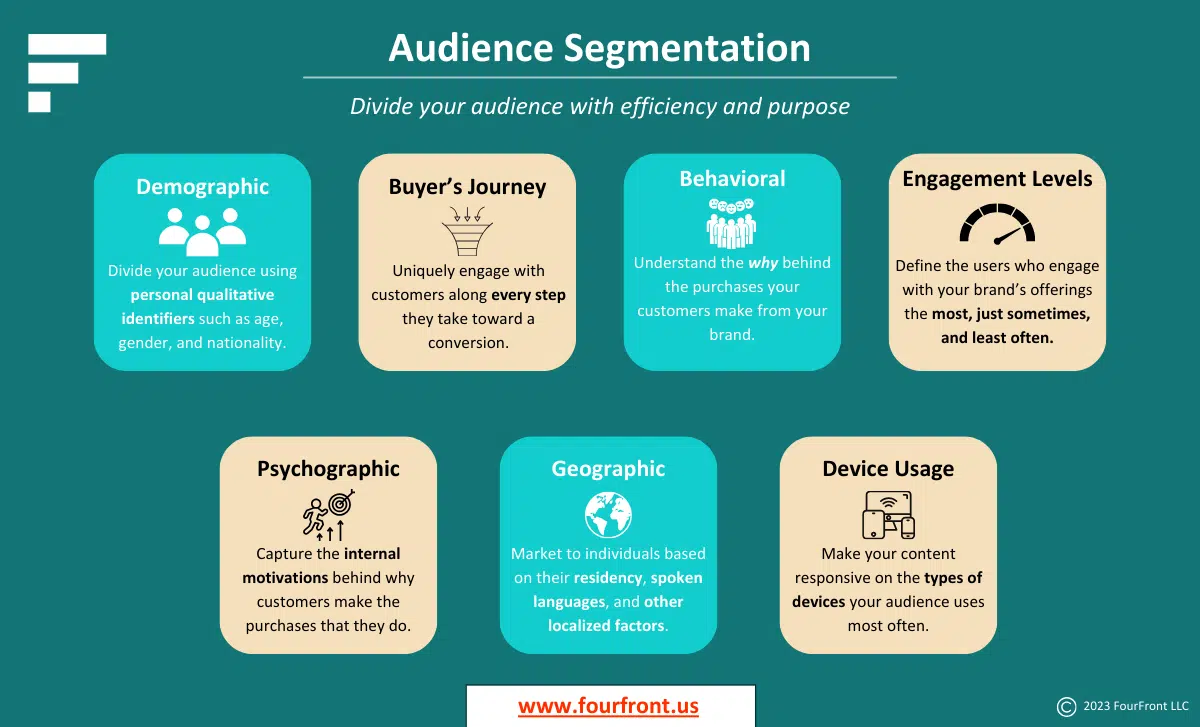
By meticulously following these steps, you ensure your content marketing strategy framework is tailored to attract and engage your specific audience, thereby establishing an effective content marketing strategy.
2. Set Up Your SMART Goals
Establishing clear goals is crucial for monitoring progress throughout your content marketing strategy for B2B businesses. This approach provides motivation and a unified direction, ensuring every decision aligns with a specific outcome. Many businesses falter by setting unrealistic goals, hindering meaningful progress. To avoid this pitfall, we recommend using SMART goals. But what exactly are SMART goals?
SMART stands for Specific, Measurable, Attainable, Realistic, and Timely. Adhering to these criteria helps your content strategy framework chart a clear path to success. Let’s delve into each element of a SMART goal:
- Specific: Goals should be detailed and precise. Avoid vague terms like “increase open rates” or “grow the number of website visitors.” Instead, set exact figures and timelines. Clearly defining success ensures you recognise when you achieve your goal.
- Measurable: It’s essential that your goals can be accurately measured. This focus helps you stay committed and assess the impact of your content marketing strategy.
- Attainable: Assess whether you have the necessary resources, skills, knowledge, budget, and tools to achieve your goals. If there are gaps, identify how to bridge them, such as through training or acquiring new tools. Goals must be realistic within your current capabilities.
- Realistic: Ambition is important, but your goals must be grounded in reality. Understand your business’s constraints and set practical goals that reflect your current status.
- Timely: Deadlines are vital. Establish and adhere to a solid schedule, holding yourself and your team accountable to meet these timelines.
3. A Clear Value Proposition
In a competitive market, a clear value proposition helps you stand out to your target customers. It’s essential to articulate what sets your product or service apart—whether it’s a more advanced offering, a better deal, or something uniquely valuable. Craft a direct proposition statement that outlines the benefits your product or service provides, ensuring potential customers understand your distinct value.
4. Build a Strong Brand Identity
A recognisable brand identity is pivotal for attracting leads and establishing your business as the preferred choice for your target customers. This includes developing a digital identity through visuals, website design, content, and logos, creating a distinct and memorable brand voice.
Once your brand image is established, target your ideal prospects by meeting their needs and engaging with them on the platforms they use most frequently, such as Twitter, Instagram, Facebook, and Reddit. Storytelling is a powerful tool for building a strong brand identity. Share your brand’s origin story, discuss your ethics, and add a personal touch to your content marketing strategy. Storytelling enhances engagement and intrigue among prospects.
5. Measure Key Metrics
For an effective content marketing strategy, measuring key metrics is essential to monitor progress and identify areas for improvement. Avoid the mistake of focusing on irrelevant metrics that don’t offer a clear picture of your website’s performance. Instead, measure metrics that directly align with your goals and accurately track your progress.
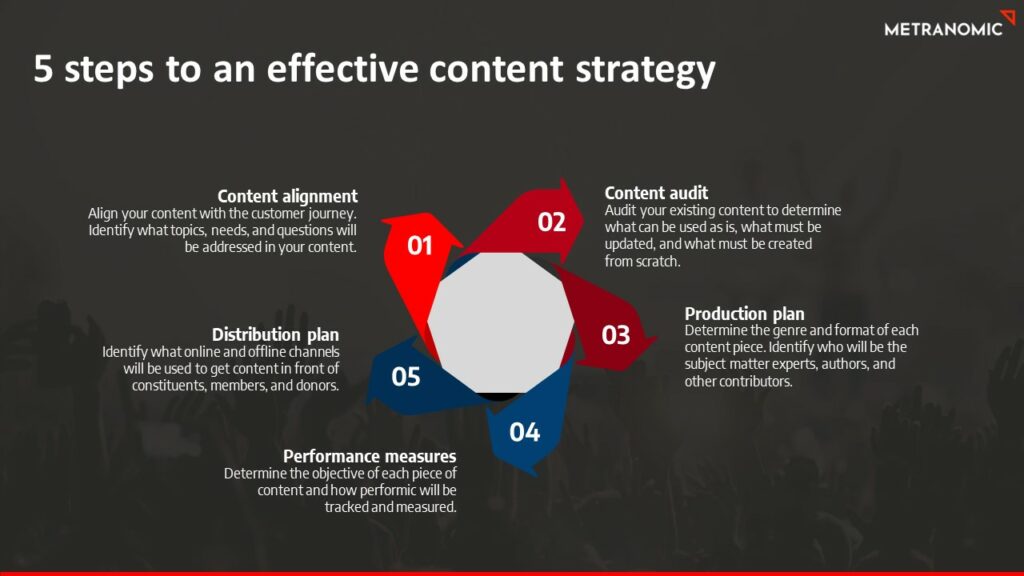
Most Useful Types of Content for Your Content Marketing Strategy
Blogs
Blogs are a cornerstone of content marketing tactics, enabling businesses to promote products, discuss industry trends, and showcase expertise. Typically, businesses publish blogs on their own websites, but guest blogging on other sites is also common for link-building opportunities. While primarily text-based, blogs often incorporate custom images and videos to enhance reader engagement.
Blog posts are highly popular in content marketing strategies due to their affordability, search engine friendliness, and ease of creation compared to multimedia content. Effective content marketing strategies leverage blogs to stand out to both human readers and search engines.
To maximise the value of blogging, focus each article on a single topic. It’s beneficial to create a mix of short-form (500 to 1,000 words), medium-form (1,200 to 2,000 words), and long-form content (over 2,000 words). However, remember that longer content isn’t always better; the key is to provide substantial value. Use headers, bullet points, and bold text to keep readers engaged and improve readability.
Video
Video is increasingly vital in content marketing optimisation. Whether hosted on your website or platforms like TikTok or YouTube, videos can convey complex ideas and emotions swiftly and effectively. The rise of smartphones has made it easier and more affordable to produce high-quality branded videos, complete with visuals, music, and voiceovers.
Businesses utilise video to demonstrate products, share customer testimonials, tell employee stories, and announce new features. Some brands even create immersive experiences, such as virtual concerts or interactive game shows, to strengthen their connection with viewers.
Infographics
Infographics compile intriguing statistics and facts into visually appealing formats, making them a staple of B2B content marketing. They are also effective in B2C contexts, particularly for explaining instructions or highlighting product features. Often, businesses transform high-level points from blogs into infographics, making complex information more accessible.
Infographics are invaluable because they condense extensive concepts into engaging visuals that are easy to read and share. In a world where audiences prefer skimmable content, infographics allow your brand’s message to be consumed quickly. Additionally, businesses can segment infographics into smaller images for social media sharing, increasing their reach and impact.
Ebooks
Ebooks are a significant element of B2B content marketing strategies. While some B2C brands use ebooks to educate consumers about product features or company-specific issues like sustainability, they are most popular among B2B brands. Ebooks often serve as lead magnets, helping businesses collect readers’ email addresses for lead nurturing.
To be effective, ebooks must deliver genuine value. This can be achieved by presenting original research, compiling industry insights, or offering exclusive information not available elsewhere. Properly executed, ebooks can generate leads and enhance brand authority.
By incorporating these types of content into your content marketing strategy, you can create a robust and effective content strategy framework that drives engagement and optimises performance across various platforms. Remember, each type of content should be strategically used to complement your overall content marketing tactics, ensuring seamless integration and maximising impact.
Our Tactical Recommendations
From our experience, clients often benefit most when they directly address customer questions in their content, as it builds trust and drives conversions. Typically, we see that leveraging video content, especially for complex topics, significantly boosts engagement and understanding. Furthermore, clients often discover that integrating content across all marketing channels creates a seamless and cohesive experience, amplifying the content’s reach and impact. These tactical approaches are essential for ensuring that your content not only reaches but also resonates with your target audience, driving actionable results.Get In Touch
Our 7-Step Process for Outlining Your Content Marketing Strategy for B2B Businesses
Below are our seven steps to crafting an effective content marketing strategy that will help you drive web traffic, boost customer engagement, improve brand loyalty, and optimise your customer experience.
Step 1: Audit Content
In today’s digital landscape, we have access to an overwhelming amount of online content, with over 1.6 billion websites available. Therefore, it is crucial to produce content that resonates with your target audience.
To ensure your content is both relevant and engaging, start by collecting and auditing your existing content. Analyse what is performing well and identify areas for improvement. This audit will help you optimise your current and future content for your specific audience, ensuring your content marketing optimisation efforts are on point.
Step 2: Clearly Outline Your Marketing Goals
Aligning each piece of content with your marketing goals is essential. Whether your objectives include boosting web traffic, increasing brand engagement, or generating more leads, having clear goals will guide your content strategy framework.
Goal-Setting Frameworks
CLEAR (Collaborative, Limited, Emotional, Appreciable, Refinable) is a framework that helps set flexible and realistic goals:
- Collaborative: Your goals should encourage teamwork within your organisation.
- Limited: Set a specific timeframe for achieving your goals.
- Emotional: Goals should inspire and motivate your employees.
- Appreciable: Break goals down into clear, manageable steps.
- Refinable: Adapt your goals in response to changes within your business.
OKRs (Objectives and Key Results) is another effective framework for defining and tracking measurable goals. Follow these steps to target ambitious goals:
- Set a challenge for each goal.
- Measure 3-4 key results against your goals.
- Gradually assess the progression of your goals from 0 to 100%.
- Create transparent goals for seamless collaboration.
- Align your goals with any changes in your marketing strategy.
- Adjust goals that no longer fit your overall marketing vision.
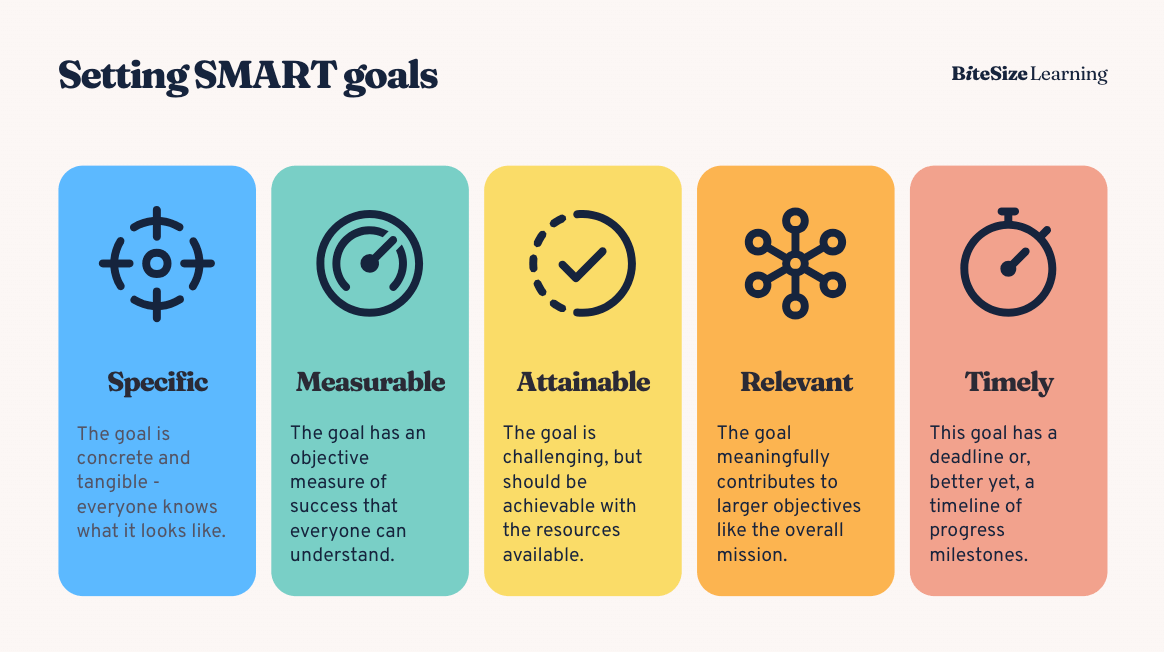
Step 3: Clearly Identify Your Target Audience
A robust content marketing strategy begins with a deep understanding of your target audience. Identify their pain points, needs, lifestyle, hobbies, and more. Delivering varied content (blogs, webinars, newsletters, FAQs) that educates, engages, and persuades will help attract and retain your audience.
A great example is Red Bull. They produce engaging content that resonates with their audience’s interests, such as extreme sports and unique experiences. This approach helps Red Bull build long-term brand loyalty by tapping into the passions and hobbies of their target market.
The Empathy Map
The empathy map is an invaluable tool for gaining a deep understanding of your target audience. This collaborative tool involves stepping into your customers’ shoes to comprehend their shopping experience. It helps you discern what they see, feel, and think about your brand, products, or services. Using an empathy map can significantly enhance your overall customer experience, leading to more effective content marketing optimisation.
The “Jobs to Be Done” Framework
The “Jobs to Be Done” framework is another excellent approach for identifying why customers use your product. This method helps you understand your customers’ pain points and the solutions they seek. For instance, they might need a new tool to improve time management or a CRM system to enhance business productivity. By clearly understanding these needs, you can align your content marketing strategy with solutions that directly address these pain points, thereby fostering brand engagement.
Step 4: Create an Effective Editorial Plan
Developing a structured editorial plan is crucial for maintaining a clear overview of your content assets and executing your content strategy framework effectively. Here are three steps to ensure your content marketing strategy remains organised and on track for success:
Prioritise Your Tasks
Prioritising workflows within your content marketing team is essential for building a robust editorial plan. By strategically identifying and executing the most critical content marketing tasks, you ensure high standards and efficiency.
Identify the Most Relevant Topics
After prioritising your tasks, the next step is to identify topics that will engage your target audience. Utilise innovative topic research tools such as BuzzSumo, Google Trends, and Quora to find relevant subjects, subtopics, and related questions that resonate with your brand. Once you have identified the right topics for your content hubs and pillars, place them on a content calendar. This tool is invaluable for tracking upcoming and missed deadlines.
Organise Work with an Editorial Calendar
An editorial calendar is crucial for tracking, monitoring, and streamlining collaboration within your content marketing team. It helps keep track of content creation, publication, and analysis, ensuring a seamless and organised approach to your content marketing strategy.
Step 5: Plan Your Content Production
To cultivate brand loyalty and enhance customer engagement, it’s vital to plan the content formats for each stage of your customer’s buyer journey. By strategically implementing diverse content marketing tactics, you can optimise the customer experience throughout their journey.
- Awareness Stage: At the beginning of the sales funnel, focus on creating content that educates, informs, and entertains potential leads. Utilise blog posts, lead magnets, infographics, SEO content, and social media posts to address key questions and needs of your audience. These content formats are ideal for capturing the attention of incoming leads and providing valuable information.
- Consideration Stage: During the consideration stage, employ content such as podcasts, webinars, testimonials, and case studies. These formats offer examples of how other customers have addressed their pain points and provide actionable steps for your leads to solve similar issues. This content is crucial for building trust and demonstrating the value of your solutions.
- Decision Stage: To support prospects in the decision stage, utilise case studies, client reviews, and testimonials. These formats help your target audience understand the benefits of your product or service through real-world examples and comparisons, facilitating informed purchasing decisions.
- Retention Stage: Post-purchase engagement is essential for retaining customers. Offer a mix of content such as emails, social media polls, YouTube videos, and more to keep your customers engaged and satisfied. Continuous engagement helps maintain a strong relationship and encourages repeat business.
- Advocacy Stage: To foster brand loyalty and turn customers into advocates, provide engaging newsletters, emails, loyalty programmes, and exclusive content for members. This strategy not only emphasises brand loyalty but also incentivises customers to promote your brand to others.
Create SEO-Friendly Content
Incorporating SEO-friendly content into your content strategy framework is a powerful way to boost organic traffic to your website. By optimising your content for search engines, you increase visibility and attract more qualified leads.
Repurpose Your Content
Repurposing content is an effective content marketing optimisation tactic that can make your content more appealing and extend its reach. Here are five clever ways to repurpose your content:
- Transform blog posts into videos or infographics.
- Break long-form content into smaller, bite-sized segments.
- Combine short pieces to create comprehensive long-form content.
- Develop and promote slide presentations.
- Share exciting snippets and eye-catching images on social media.
Take Advantage of User-Generated Content
User-generated content, such as reviews, comments, photos, and videos, is highly influential and can enhance your brand’s credibility. Implementing user-generated content into your strategy can provide authentic insights and foster a stronger connection with your audience.
Step 6: Content Distribution Planning
A critical component of your content marketing strategy involves the use of earned and paid media. Building an omni-channel experience ensures your brand remains relevant and continuously engages your audience.
- Build an Omni-Channel Experience: Promote and deliver your brand through a variety of marketing channels to keep your audience engaged at all times. This approach maximises your reach and reinforces your brand’s presence across different platforms.
- Identify Relevant Channels: To strengthen your content marketing strategy, identify the channels that your target audience engages with the most. Use social media analytics and demographic insights to determine the most effective platforms for your content.
- Social Media Posting on an Automated Basis: Automating your social media posts on platforms like Facebook, Twitter, LinkedIn, and Instagram can save time and ensure consistent engagement with your audience. This approach helps maintain a continuous presence and keeps your brand top of mind.
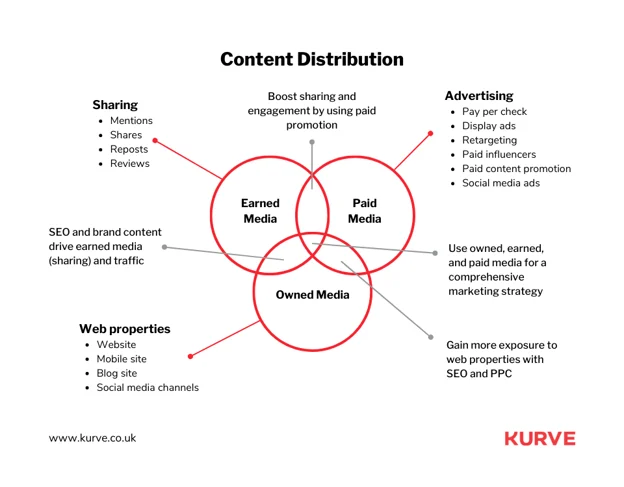
Step 7: Analyse Your Content Performance
Tracking content performance across all platforms is essential for identifying the most engaging content for your target audience. Here are four key metrics to monitor:
- User Behaviour: Track web visitors, pages per session, and bounce rates.
- Engagement: Measure likes, shares, comments, and mentions.
- SEO Results: Monitor organic traffic and backlinks.
- Company Revenue: Analyse the number of leads and conversion rates.
By consistently analysing these metrics, you can refine your content marketing strategy to better meet the needs of your audience and achieve your business objectives.
Content Marketing Strategy Challenges
Not Having a Content Promotion Plan
Creating stellar content is only half the battle; if it doesn’t reach the right audience, its impact is severely diminished. Promotion is crucial in ensuring your content marketing strategy is effective. Neglecting to promote your content means missing out on potential engagement opportunities and could lead to decreased visibility.
Ignoring User-Generated Content
User-generated content (UGC), such as testimonials and reviews, is highly valuable due to its authenticity. Despite its influence on buying decisions, many marketers overlook this vital resource. Incorporating UGC into your content marketing tactics can significantly enhance credibility and trust.
Overlooking Mobile Optimisation
In today’s digital age, ignoring mobile optimisation is a critical error. Mobile responsiveness is essential, as a lack of it can lead to a high bounce rate. Ensuring your content is mobile-friendly is a key aspect of content marketing optimisation.
Not Using Visuals and Multimedia
Visual storytelling is a powerful tool that many marketers fail to utilise fully. Integrating multimedia elements such as images, infographics, and videos can significantly boost engagement and prevent content redundancy. An effective content marketing strategy should include a variety of visual elements to captivate your audience.
Not Knowing Your Audience
Understanding your audience is fundamental to hitting the mark with your content. Failing to know your audience’s preferences, interests, pain points, and behaviour patterns can derail your content marketing strategy. Take the time to thoroughly research and understand your ideal clients to tailor your content to their needs effectively.
Not Optimising for SEO
Search engine optimisation (SEO) is crucial for ensuring your valuable content is discoverable. Overlooking SEO or treating it as an afterthought can undermine your content marketing efforts. SEO should be integrated into every aspect of your content marketing strategy to maximise visibility and impact.
By addressing these challenges, you can refine your content marketing strategy framework, ensuring it is robust, comprehensive, and poised for success.
